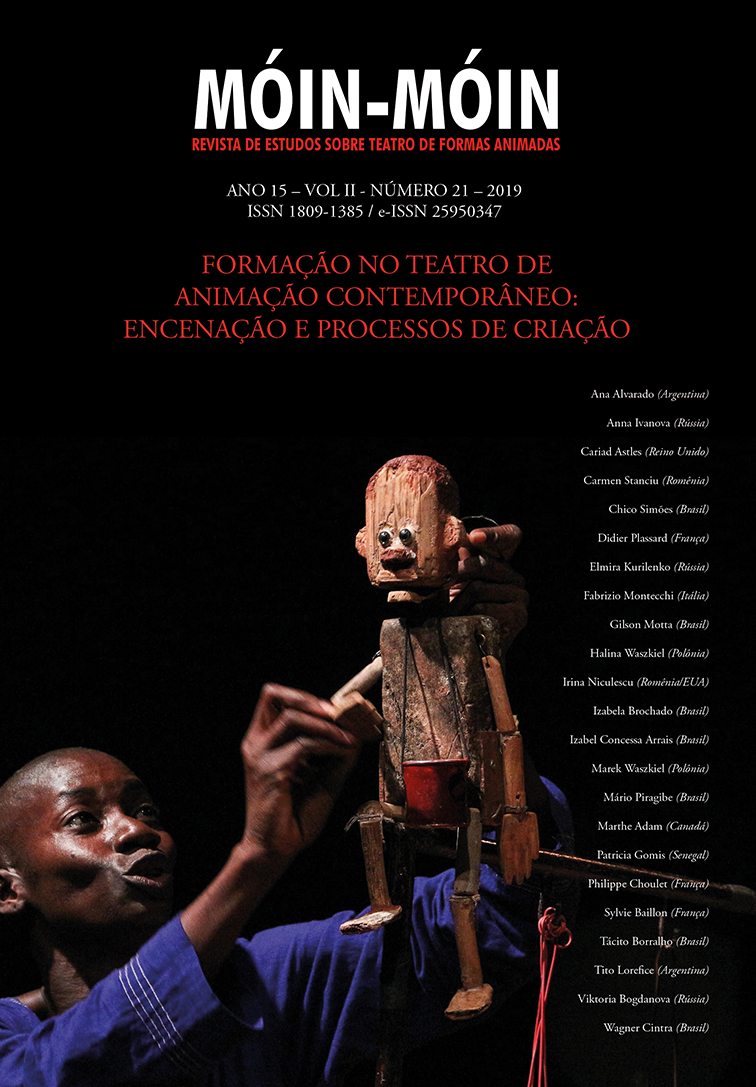Image-based theatre: a new pedagogy for a “new” theatre
DOI:
https://doi.org/10.5965/2595034702212019193Abstract
This article captures the one-hour presentation, discussions and interactive
dialogue at the conference: The theatrical function of the image and its relation to the other elements of staging. Pedagogical approach. The main idea of the conference is that nowadays the context of performing arts claims a reconsideration of the pedagogical approach of the profession of theatre director. I will recall how the “job” of theatre director has emerged in 19th century as a logical result of the industrialisation. Bringing electric light into theatre auditoriums, building bigger theatres with wider stages, the appetence of the public for elaborate and realistic staging using 3D props and complicated machineries – all this imposed the necessity of a man who has or develops the skills and knowhow of staging. And that’s how the history of the world theatre was re-written in the 20th century – The Century of the Director. Moreover, the two most influential theatre people of the last century where both directors and professors: Konstantin Stanislavsky and Bertolt Brecht. But what about our 21th century? Is theatre still “a play ground” for the directors? My theory is that the performing arts today are erasing the “traditional” patterns of theatre makers under the pressure of the new role that theatre is claimed to perform in
society. The theatre of Digital Era needs to have the same “pixeled” structure as every other human creation. That’s why I strongly believe that the pedagogy of theatre must be reconsidered and reorganized having as its central idea the dichotomy between the dramatic and the post-dramatic structure of the play. After all, as Peter Brook said: “A play is a play.” As support for demonstration and discussions I will use Meyerhold’s theory on how to construct a performance, Schlemmer’s diagram on types of performances, Brecht’s
remarks on dramatic theatre vs. epic theatre, Lehmann’s theory on post-dramatic theatre and Erika Fischer-Lichte’s arguments on transformative aesthetics. I will use images from shows staged by outstanding theatre directors, which marked or/and are marking how we make and look at theatre today.
Downloads
Downloads
Published
How to Cite
Issue
Section
License
Copyright (c) 2019 Móin-Móin - Revista de Estudos sobre Teatro de Formas Animadas

This work is licensed under a Creative Commons Attribution 4.0 International License.
The readers are free to transfer, print and use the articles published in the Magazine, as long as there’s explicit mention to the author(s) and to Móin-Móin Magazine - Studies in Theater of Animated Forms and there are no changes on the original work. Any other use of the texts needs to be approved by the author(s) and the Magazine. In submitting an article to Móin-Móin Magazine - Studies in Theater of Animated Forms and have it approved, the author(s) agree to give away, without payments, the following rights to the Magazine: first publishing rights and the license for the Magazine to redistribute this article and its metadata to index and reference services that the editors consider appropriate.
The articles whose author(s) are identified represent the author’s point of view and not the official position of Móin-Móin Magazine. The author(s) commit to always mention the publication in the following way when publishing work in reference to the article published in Móin-Móin Magazine:
“This article was originally published by Móin-Móin Magazine volume (insert the volume), number (insert the number), in the year of (insert year) and can be accessed on: http://www.revistas.udesc.br/index.php/móin"
Plagiarism in any way constitutes an unethical publishing behavior and is unacceptable. Móin-Móin Magazine holds the right to use software or other plagiarism tracking methods to scan the submitted works.
![]()
This journal uses Attribution-NonCommercial 4.0 International– (CC BY NC 4.0).






